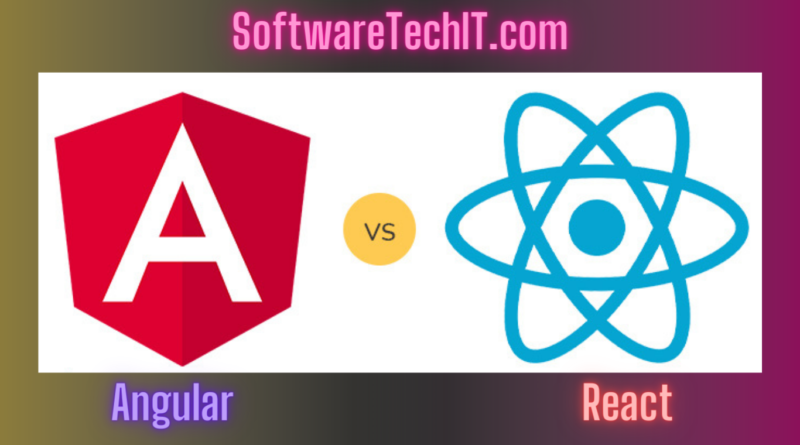Angular Vs React: Difference Between Angular and React
Table of Contents
Web development is increasing at the same rate as technology.
When you think about the JavaScript Ecosystem, you’ll almost certainly think of Angular and React, as they’re two of the most popular front-end development frameworks. But how can you pick between angular vs react? Should you base your selection on the project’s specifications first? Or, in the early stages, consider its popularity and ramp-up time?
What’s the difference between Angular and React? For years, there has been a violent rivalry between these two prominent front-end frameworks. So, which option is the best?
Every time front-end programming is required, the Angular vs React debate occurs. The answer relies on a variety of circumstances, and even front-end developers have debated the topic for years.
What is Angular?
Angular is a Google-developed and maintained web framework that was first released in 2010 under the name AngularJS. It quickly became one of the most popular web frameworks at the time. This was owing to capabilities like two-way data binding and dependency injection, as well as the fact that it was supported by a tech giant.
Angular (also known as Angular 2.0) was released in September 2016 as a complete redesign of AngularJS (Angular 1.0), which was first released in 2010.
What is React?
React, a JavaScript library used by Facebook, was open-sourced in 2013. This framework popularised a web development concept known as component-based architecture, which has a number of benefits, including:
Components that are modular and coherent, making them highly reusable and contributing to a faster development time.
It’s used in mobile development since it allows developers to reuse the logical section of an app while simply changing the view.
Easy maintenance and improvement due to self-contained components.
React immediately swept the market, overtaking most of the frameworks available at the time, including AngularJS. As a result of the community’s passion for component-based architecture, Google improved their JavaScript framework in 2016 and named it Angular2.
Key Features of Angular
- Built-in support for AJAX, HTTP, and Observables are just a few of Angular’s highlights. There is widespread support in the community.
- In line with current technologies
- Typescript is time-saving.
- Coding that is more clear and concise
- Error-handling support has been improved.
- Angular CLI allows for seamless updates.
- Validation and forms
- Local CSS / shadow DOM
- Separation of User Interface and Business Logic
Key Features of React
- React’s key features include the ability to use third-party libraries.
- Time-Saving
- Composability and Simplicity
- Facebook is fully behind you.
- Improved user experience and lightning-fast speed.
- More rapid development
- One-directional data binding provides code stability.
- Components in React
Key Difference of Angular vs React
- Purpose
- Data Binding
- Language
- UI Components
- Dependency Injection
- DOM
Angular vs React
| Basis of Distinction | Angular | React |
| Purpose | Full-featured Framework – provides a strong opinion on how your application should be designed, as well as a number of tiny libraries that aid in the development of complex applications. | The library is only concerned with UI components. MVC design requires Flux to implement, but it provides you more flexibility in how you wish to organise your code. |
| Data binding | Supports both one way and two way data binding ,two-way data binding means that if we modify the UI input, the model state will change, and vice versa. | One-way data binding means that a UI element can’t affect a component’s state. |
| Language | TypeScript is a statically typed language that is a superset of JavaScript. | TypeScript can write JavaScript XML (JSX), although it isn’t included by default. |
| UI Components | Material Design Components – Angular includes a number of material design components that make UI configuration a breeze. | Material-UI Library & Dependencies – Community-developed UI tools provide a wide range of UI components. |
| Dependency Injection | Dependency injection is supported, allowing for separate life cycles for different stores. | React does not fully enable dependency injection because each component has its own global state. |
| DOM | Incremental DOM – when a new DOM is created, it compares it to the previous one and applies the differences to the “actual” DOM, only allocating memory if necessary. | Virtual DOM – anytime the DOM changes, a new virtual DOM is created, compared to the previous one, and only the differences are modified in the “real” DOM. |
Advantages of Angular
The following are some of the advantages of utilising Angular:
- Clean code development is available.
- Increased Efficiency
- Interface Inspired by Material Design
- Because an angular framework can handle routing, switching from one view to another is simple.
- Angular CLI for Seamless Updates
Disadvantages of Angular
The following are some disadvantages and issues with utilising Angular:
- For newbies, an angular feature can be perplexing.
- There isn’t a clear manual or comprehensive, all-encompassing documentation.
- The learning curve is steep.
- Limited Routing makes it difficult to debug scopes.
- When pages have interactive components, Angular can become slow.
- Integration with third parties is extremely tough.
- Several complications may arise when upgrading from earlier versions to newer versions.
Advantages of React
The following are some of the advantages of utilising React:
- Because of its straightforward design, it is simple to learn.
- The HTML-like syntax enables for templating as well as extensive documentation.
- Developers can spend less time worrying about framework-specific code and more time writing current JavaScript.
- Improve server-side rendering capability, making it a more robust platform for content-focused apps.
- React allows you to migrate between versions.
- Facebook has a feature called “codemod” that automates a lot of the process.
- React skills can be transferred to Native development.
- ReactJS is ideal for managing huge loads with relative ease when combined with ES6/7.
Disadvantages of React
The following are some of the drawbacks and issues with using React:
- Integrating Reacts with a typical MVC framework like Rail necessitates a lot of setup.
- Users using ReactJS would need a thorough understanding of how to integrate a user interface with the MVC framework.
Conclusion
With so many frameworks to pick from, each with its unique set of characteristics, settling on the best framework can be a difficult task.
We felt the same way when we first opted to build the app in Vue.js and now while we’re exploring Angular.
When it comes to choosing between Angular and React, I believe it comes down to personal preference, as they both tackle the same problems but in different ways.
However, when making a selection, keep in mind that React has a simpler learning curve, which leads to faster development, but Angular offers more built-in functionality.
Both technologies are extremely powerful, a significant advancement from the early days of web programming in terms of improving, facilitating, and speeding up development.
FAQs
How is React different from Angular?
React is a library, but Angular is a full-fledged framework. The virtual DOM and one-way data binding are used by React.js, but the real DOM and two-way data binding are used by Angular. There’s also a speed difference (React’s is faster) and a difference in bundle size (React’s is smaller) (React works a bit faster).
Is Angular better than React?
Because of its virtual DOM implementation and rendering optimizations, React outperforms Angular. It’s also simple to switch between React versions; unlike Angular, you don’t have to install updates one by one. Finally, using React, developers have access to a wide range of pre-built solutions.
Can I learn Angular if I know React?
Yes, knowing how to react is beneficial, but you should not stop there; instead, strive to master it. Of course, you can accomplish almost anything with React that you can do with Angular (perhaps even more), but as a software developer, I believe you should master Angular.
Why is React faster than Angular?
React.js apps make use of a virtual DOM, which allows developers to make changes without having to rewrite the full HTML document. It ensures speedier performance by rendering updates faster.
Additional Resources
- Angular MCQ
- Angular Interview Questions
- AngularJS Interview Questions
- Angular 8 Interview Questions
- Angular Vs Angular JS
- React Interview Questions
- React Components
- React Tutorial
- React Projects
- Angular Project
- Angular Tutorial
- CRUD Operations In Angular
- Angular Librarys





Pingback: Angular 16 Is Launch: Discover the Top 7 Features | Angular Developer - SoftwareTechIT